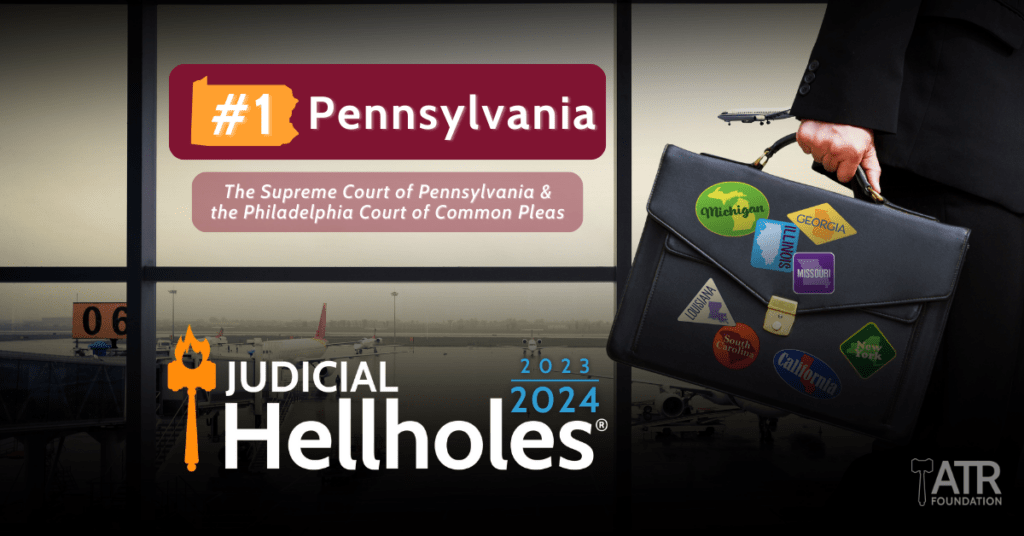‘Highly Unusual’ Rehearing of Louisiana Case Raises Judicial Independence Concerns
Louisiana Supreme Court Waffles Under Political Pressure, ATRA Brief Urges Court to Stand Strong

From nuclear verdicts to litigation tourism, Keystone State grapples with myriad legal challenges
Pennsylvania’s judiciary takes center stage as the Supreme Court of Pennsylvania and the Philadelphia Court of Common Pleas jointly claim the unenviable top spot in the latest Judicial Hellholes® report released today.
This year’s report, published by the American Tort Reform Foundation, spotlights escalating nuclear verdicts, medical liability lawsuits, litigation tourism, mass torts litigation in Philadelphia, and liability expansion by the Pennsylvania Supreme Court.
ATRF attributes the high ranking, in large part, to Philadelphia and the Pennsylvania Supreme Court encouraging “lawsuit tourism,” where plaintiffs are allowed to flood courts with lawsuits that have little connection to the venue.
A late November decision from the Pennsylvania Supreme Court solidified the courts’ rankings, ATRF said. The Hangey v. Husqvarna decision opens up plaintiff-friendly courts, like the Philadelphia Court of Common Pleas, to even more cases that lack a direct connection to the venue.
“The Court’s expansion of the state’s venue rule will only further the forum-shopping problem already plaguing the Pennsylvania judicial system,” Tiger Joyce, president of the American Tort Reform Association said.
In June, the U.S. Supreme Court’s decision in Mallory v. Norfolk Southern Railway, which originated in Pennsylvania, expanded certain state courts’ jurisdiction over out-of-state companies. Pennsylvania’s business registration statute is used to subject out-of-state businesses to lawsuits in Pennsylvania, even when there’s no real connection to the state.
“Philadelphia’s Court of Common Pleas long has been a preferred venue for out-of-state cases, but this year’s unfortunate U.S. Supreme Court decision opens the floodgates for even more out-of-state litigation,” Joyce said. “While traveling trial lawyers may benefit, middle-class Pennsylvania families pay the price as businesses flee the state, taking well-paying jobs with them.”
Pennsylvanians pay nearly $1,400 every year in a “tort tax,” leading to 171,000 jobs lost annually due to excessive tort costs.
“Lawsuit abuse isn’t just legal jargon — it directly impacts the cost of living for hard-working, Pennsylvania families,” Joyce said. “As more lawsuits flood the system, costs and prices rise, making it challenging to make ends meet.”
Trial lawyers file or move cases to Philadelphia because they know they’re more likely to win. The Pennsylvania Supreme Court eliminated the state’s venue rule for medical liability cases last year. Through October, Philadelphia medical liability filings increased 108% when compared with the same period in the previous year.
With increased liability risks come increased costs, ATRF says. Following the rule change, medical malpractice insurance rates went up, with some premiums increasing between 10.5% and 16.1%.
“This surge not only strains the court system but also impacts healthcare costs for patients,” Joyce said. “Escalation of medical liability can lead to an access to care crisis by driving doctors away from the state due to mounting costs.”
Litigation costs sometimes go nuclear — a rise in “nuclear” verdicts, those exceeding $10 million, is another critical concern cited in the Judicial Hellholes® report.
Two recent nuclear verdicts caught ATRF’s attention: A $175 million verdict involving Roundup® weedkiller and a nearly $1 billion product liability verdict against Mitsubishi, stemming from a car accident.
The first, ATRF says, contradicted scientific consensus and previous defense verdicts.
Further, post-trial revelations suggest jury irregularities, with improper, off-the-record instructions from Judge James Crumlish potentially influencing the outcome.
The second, nearly $1 billion awarded in October, is the largest crashworthiness verdict ever recorded in the state and involved negligence allegations in the seat belt design. ATRF highlights key legal considerations omitted from the court’s instructions as well as critical evidence kept from the jury.
Rulings from Pennsylvania’s Supreme Court earlier this year related to punitive damages and premises liability already created unease among businesses, ATRF says.
In Bert v. Turk, Pennsylvania’s Supreme Court endorsed a per-defendant approach to calculating punitive damage ratios, potentially driving up damage awards across the state and raising the possibility of more nuclear verdicts.
The state supreme court reshaped premises liability law in May by holding contractors responsible for hazards even after completing their work, in Brown v. The City of Oil City.
ATRF says they’ll have their eye on three notable premises liability cases in the coming year. The first involves a fatal stabbing at a McDonald’s in Philadelphia County, claiming the restaurant should have foreseen the risk of violence and provided adequate security. The other two cases involve acts of violence outside South Philadelphia’s iconic Pat’s King of Steaks, one case alleging negligence and another claiming the restaurant had a duty to protect customers or intervene in the altercation.
“Pennsylvania businesses face daunting challenges due to the state supreme court’s barrage of liability-expanding decisions,” Joyce said. “Premises liability lawsuits related to criminal acts beyond a business’s control increasingly target businesses in high-crime areas. These lawsuits may lead to store closures or higher prices for shoppers to offset significant costs of additional security measures.”
Pennsylvania’s courts tied for the No. 1 Judicial Hellholes® ranking with Georgia. This is the first time ATRF has named two No. 1 Judicial Hellholes®.
Learn more and read the full report at JudicialHellholes.org.
Louisiana Supreme Court Waffles Under Political Pressure, ATRA Brief Urges Court to Stand Strong
Left unchecked, these jurisdictions will continue dragging down economic growth and undermining justice through rampant lawsuit abuse.
Claimants Given Opportunity to Vote on Plan; Judge to Reconsider Scientific Validity of Plaintiffs’ Experts
Legitimate consumer protection demands sound science and impartial analysis — not distorted data designed to manufacture lawsuits.
Law Firms Spent $168M+ on 2.2M Ads in Georgia
ATRA’s Latest Studies Reveal Financial Influence and Lack of Transparency in Pennsylvania’s Campaign Finance Systems